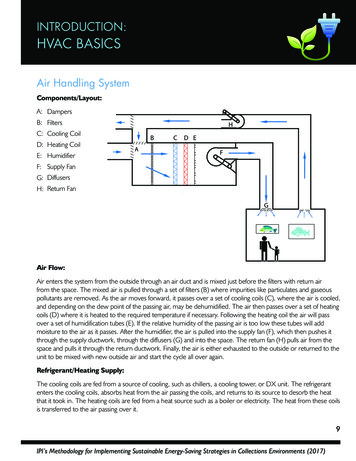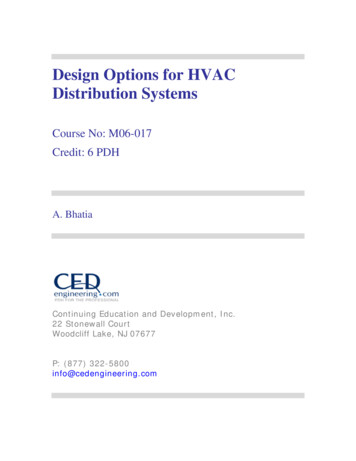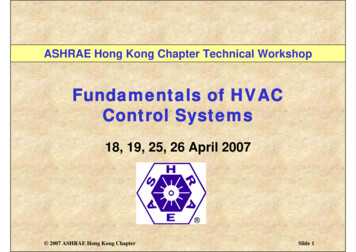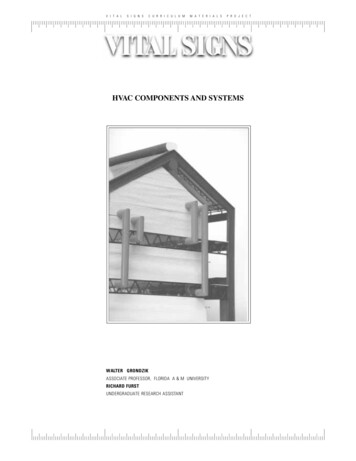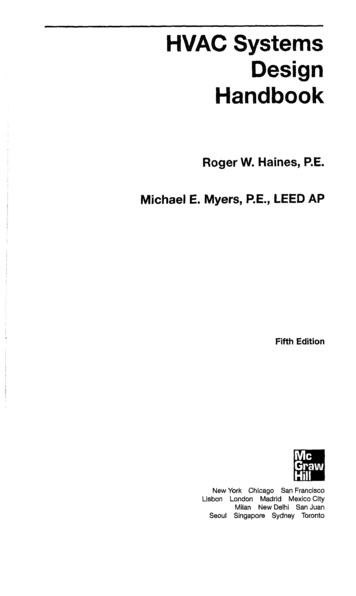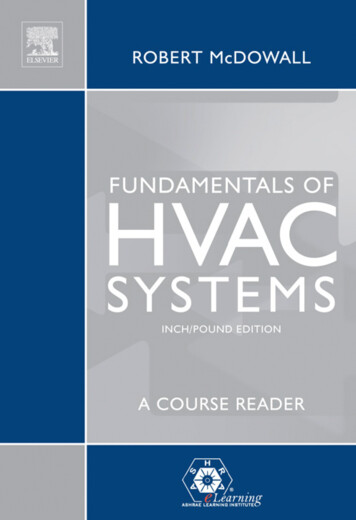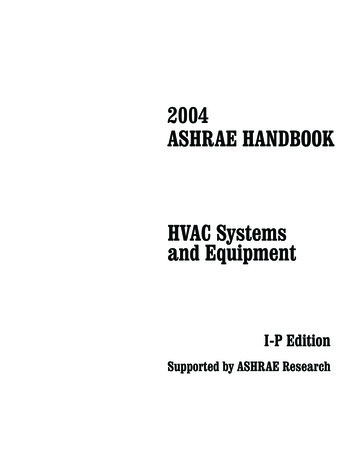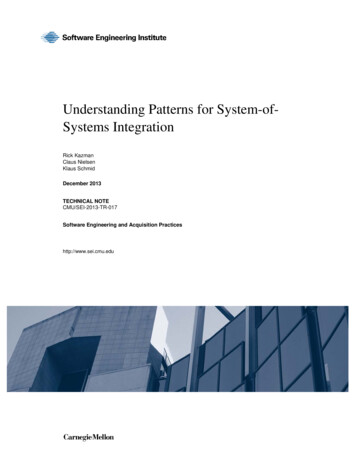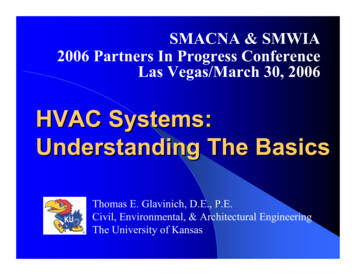
Transcription
SMACNA & SMWIA2006 Partners In Progress ConferenceLas Vegas/March 30, 2006HVAC Systems:Understanding The BasicsThomas E. Glavinich, D.E., P.E.Civil, Environmental, & Architectural EngineeringThe University of Kansas
Forecasting The Future“ the most reliable way toanticipate the future is byunderstanding the present.”John NaisbittMegatrends
st21zzzzzzCentury BuildingsPurpose of a building is to provide a controlledenvironment for occupants.Building is a collection of systems that provide acontrolled environment.Systems’ integration is the key to effective and efficientbuilding operations.Buildings will be optimized as a system.Traditional approach: optimize building subsystemsleaving building suboptimal.Building quality will be measured by its ability toefficiency support the activity it houses - not its utilitybills.HVAC Systems Establish Environment
Sustainable ConstructionLEED: Energy & AtmosphereEA P1 Fundamental Building CommissioningEA P2 Minimum Energy PerformanceEQ P3 CFC Reduction In HVAC&R EquipmentEA C1 Optimize Energy PerformanceEA C2 Renewable EnergyEA C3 Independent CommissioningEA C4 Ozone Protection (No HCFCs)EA C5 Ongoing Measurement & VerificationExample HVAC System Related Prerequisites & Credits
Sustainable ConstructionLEED: Indoor Environ QualityEQ P1EQ P2EQ C1EA C2EA C3EA C5EA C6EA C7Minimum IAQ PerformanceETS ControlCarbon Dioxide MonitoringVentilation EffectivenessConstruction IAQ Management PlanIndoor Chemical & Pollutant Source ControlSystem ControllabilityThermal ComfortExample HVAC System Related Prerequisites & Credits
Building Integrated PhotovoltaicsDoxford Office Park, England (www.solarcentury.co.uk)
Smart Vision GlassPhotos by Research Frontiers, Inc. (www.smartglass.com)
ZigBee (IEEE Std 802.15.4)Wireless Bldg ControlsSelf-Organizing, Self-Healing Mesh Network
“Motes” Smart SensorszzzUC Berkeley “SmartDust” PrototypezTiny, self-contained, batterypowered sensors and computersthat use rf technology tocommunicate and exchange datawith one another.Able to self-organize into ad hocnetworks to form wireless sensornetworks.Use TinyOS.Applications in agriculture,structure monitoring, industrialcontrols, military, security, etc.Photo from David E. Culler & Hans Mulder, “Smart Sensors to Network the World,”Scientific American, June 2004.
Smart (RFID) TagszzPassiveActive
Mitsubishi “iGlassware”Mitsubishi Electric Research Laboratories (MERL)http://www.merl.com/projects/iGlassware/
Integrated AutomationOpen Architecture Control Systems:LonMark & BACnetBenjamin Stein & John S. Reynolds, Mechanical and Electrical Equipment forBuildings, John Wiley & Sons, 2000, p. 484
Security & Life SafetyzAvailable Today:––––zSurveillance CamerasBomb SniffersBasic BiometricsChemical & Bio DetectorsComing Soon:– Millimeter Wave Cameras– Vein MapszUnder Development:–––––Remote Iris TrackingEars & GaitsOdor SensorsSaliva ScansUniversal SensorsCatherine Yang, “The State Of Surveilance, BusinessWeek, August 8, 2005, pp. 52-59.
Intelligent BuildingBuilding that provides a productiveand cost-effective environmentthrough the optimization of itsstructure, systems, services, andmanagement as well as theinterrelationships between them.BICSI, Telecommunications Distribution Methods Manual, NinthEdition, pp. 21-1.
Words For Today .Convergence&InteroperabilitySMACNA/SMWIA New Role:System Integrator
HVAC Systems: Understanding The BasicsManual ObjectiveProvide a practical guide to HVACsystems including equipment andcontrols that will assist projectpersonnel in the marketing, estimating,design management, procurement,installation, commissioning, andmaintenance of HVAC systems.Systems Approach To HVAC
HVAC Systems: Understanding The BasicsTarget AudienceszHVAC Contracting Firms:–––––zProject ManagersProject EngineersEstimatorsSuperintendents & ForepersonsOthersConstruction Programs – Colleges & Universities:– Engineering (Construction Emphasis)– Construction Science, Management, & Technology– Other Related Academic ProgramszGeneral Contractors & Construction ManagersThis Is Not A Design Manual
HVAC Systems: Understanding The BasicsHow Will This Manual Be Used?z ChapterEducation Programz Self Studyz Referencez College Textz Combination
HVAC Systems: Understanding The BasicsHVAC Systems ductionBasic HVAC SystemsHVAC Control SystemsMultizone SystemsDual-Duct SystemsTerminal Reheat SystemsVariable Air Volume SystemsInduction & Induction Reheat SystemsSpecial ApplicationsHydronic SystemsUnitary & Heat Pump SystemsCooling/Refrigerant SystemsHydronic Heat Recovery SystemsEngineering Data, Tables & ChartsHVAC Systems: Understanding The Basics’ objective isto complement existing HVAC Systems Applications.
HVAC Systems: Understanding The BasicsIssues Addressed In ManualzHVAC System Operation:––––zFabrication & Installation elative System Cost & Life-Cycle EconomicsCost EstimatingProcurementSchedulingSequencing (Fragnets)ProductivityOtherCommissioning & Closeout (TAB, LEED, Etc.)
HVAC Systems – Understanding The BasicsTable Of Contents12345678910Introduction To HVAC SystemsHVAC Operating CharacteristicsHVAC System TypesHVAC Piping SystemsHVAC Air Distribution EquipmentCentral Heating & Cooling EquipmentHVAC Instrumentation & ControlHVAC Equipment InstallationSpecial HVAC Systems & EquipmentHVAC System Commissioning & Closeout
HVAC Systems – Understanding The BasicsManual FormatConventional Paper-Basedz SMACNA Publication Referencesz Problemsz Case Studiesz PowerPoint SlidesPossible Electronic Format WithHyper-Linked Topicsz
Questions?
HVAC Systems: Understanding The Basics Thomas E. Glavinich, D.E., P.E. Civil, Environmental, & Architectural Engineering The University of Kansas SMACNA & SMWIA 2006 Partners In Progress Conference Las Vegas/March 30, 2006. Forecasting The Future “ the most reliable way to anticipate the future is by understanding the present.” John Naisbitt Megatrends. 21st Century Buildings
